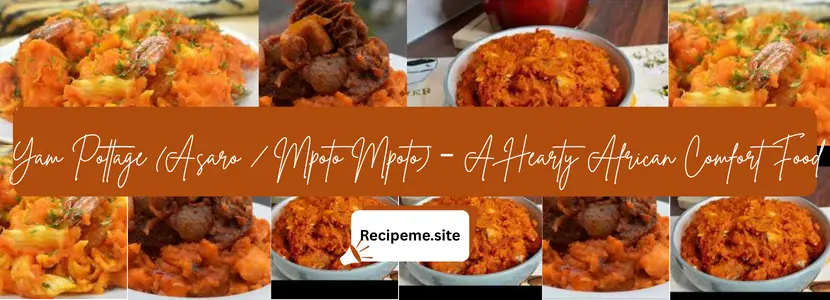
Introduction
Have you ever tasted a meal so comforting that it feels like a warm hug from childhood? That’s exactly the experience Yam Pottage (Mpoto Mpoto / Asaro) gives.Whether served at family gatherings in Nigeria, in Ghanaian homes after a long day, or at festive occasions across West Africa, this dish is more than just food—it’s a symbol of love, care, and cultural pride. With its soft, creamy texture and rich, spicy flavor, Yam Pottage instantly warms the heart and satisfies the soul.
Growing up, many recall the smell of yam slowly simmering with palm oil, crayfish, and spices filling the kitchen. For some, it was the ultimate “rainy day meal,” eaten while sitting by the window and watching the drizzle outside. That’s the magic of this dish—it nourishes not only the body but also the spirit.
History of Yam Pottage
Yam Pottage has deep roots in West Africa, particularly among the Yoruba people of Nigeria, where it is widely known as Asaro. In Ghana, it is called Mpoto Mpoto. The dish has been around for centuries, made possible by the region’s abundant yam cultivation.
Yam, one of Africa’s staple crops, symbolizes sustenance and prosperity. Communities discovered that boiling yams in a mixture of palm oil, spices, and proteins not only made it tastier but also more filling. Over time, the dish evolved into the creamy, hearty Yam Pottage we know today.
Did You Know? Nigeria accounts for about 70% of the world’s yam production, making yam-based meals like Asaro central to its cuisine.
Essential Ingredients
The beauty of Yam Pottage lies in its simple yet flavorful ingredients. Common elements include:
-
White Yam (the star ingredient)
-
Palm Oil (adds color and richness)
-
Onions
-
Tomatoes & Bell Peppers (for depth of flavor)
-
Crayfish or Dried Fish (for authentic taste)
-
Seasonings: Salt, bouillon cubes, chili, ginger, garlic
-
Green Vegetables (optional): Spinach, pumpkin leaves, or ugu
Protein Additions
Depending on preference, Yam Pottage can be enriched with:
-
Smoked fish
-
Goat meat or beef
-
Stockfish
-
Eggs
Variations of Yam Pottage
Yam Pottage isn’t one-size-fits-all. Each community or household has its spin:
-
Asaro (Nigeria): Creamy version with palm oil, peppers, crayfish, and often smoked fish.
-
Mpoto Mpoto (Ghana): Slightly lighter, sometimes cooked with garden eggs (African eggplants) and herring.
-
Vegetable Yam Pottage: Enriched with spinach, pumpkin leaves, or ugu.
-
Protein-Rich Asaro: Cooked with assorted meats for festive occasions.
-
Plain Yam Pottage: Just yam, palm oil, and onions—simple but comforting.
Preparation: Step-by-Step Guide
Here’s how to prepare authentic Yam Pottage at home.
Ingredients (Serves 4)
-
1 medium tuber of yam (peeled and cut into chunks)
-
½ cup palm oil
-
2 medium onions (chopped)
-
2 medium tomatoes
-
2 bell peppers
-
2 scotch bonnet peppers (for heat)
-
2 tablespoons ground crayfish
-
Smoked fish or beef (optional)
-
2 seasoning cubes
-
Salt to taste
-
2 cups stock or water
-
Handful of spinach or ugu leaves
Instructions
-
Prepare the Base
-
Blend tomatoes, bell peppers, and scotch bonnet into a smooth paste.
-
Heat palm oil in a pot, add onions, and fry until fragrant.
-
-
Build the Flavor
-
Add the blended pepper mix. Cook for 10–12 minutes until the oil floats on top.
-
-
Add Proteins & Crayfish
-
Stir in crayfish, smoked fish, or meat. Season with cubes and salt.
-
-
Cook the Yam
-
Add yam chunks and pour in stock or water until just covered.
-
Stir, cover, and let simmer for 20 minutes until yam softens.
-
-
Mash & Stir
-
Using a spoon, mash some yam chunks inside the pot to create a creamy base while leaving some whole.
-
-
Finish with Greens
-
Add spinach or ugu for freshness. Simmer for 3 minutes.
-
-
Serve Hot
-
Garnish with extra palm oil if desired. Serve steaming hot with chilled water or zobo drink.
-
Pro Tip: Always mash only a portion of the yam to strike the perfect balance between creamy and chunky textures.
Cultural Significance
Yam Pottage is more than just a dish—it’s a symbol of togetherness and tradition.
-
In Nigeria, Asaro is often served at naming ceremonies, housewarmings, and family gatherings.
-
In Ghana, Mpoto Mpoto is a comfort food, eaten during harvest celebrations or simply enjoyed at home.
-
Across West Africa, yam represents fertility and prosperity, making yam dishes central to cultural identity.
Serving Suggestions
Yam Pottage is versatile in presentation:
-
Pair with fried plantains for sweetness.
-
Add boiled eggs for protein.
-
Serve with grilled chicken or goat meat for a hearty meal.
-
Enjoy with chilled zobo or hibiscus drink for balance.
Types of Yam Pottage
-
Asaro Elepo (Palm Oil Yam Pottage): Rich and spicy with palm oil.
-
Vegetable Yam Pottage: With greens for extra nutrition.
-
Seafood Yam Pottage: Infused with prawns, crabs, or dried fish.
-
Festival Yam Pottage: Prepared with assorted meats during celebrations.
Tips for the Perfect Yam Pottage
-
Use white yam, as it softens and breaks down well.
-
Don’t rush cooking—the flavors develop best when simmered slowly.
-
Always balance texture: creamy but with some yam chunks intact.
-
Add palm oil toward the middle of cooking to avoid overpowering the dish.
-
Fresh vegetables at the end bring color and nutrition.
Other Valuable Information
-
Nutrition Facts: Yam Pottage is high in complex carbohydrates, fiber, potassium, and vitamins. When paired with protein, it becomes a balanced meal.
-
Hidden Cultural Note: In some Yoruba communities, Asaro is considered a healing food given to nursing mothers for strength.
-
Expert Insight: Dietitians often recommend yam-based meals for diabetics (in moderation) because yams have a lower glycemic index compared to processed carbs.
Personal Experience: My Journey with Yam Pottage
I still remember my grandmother’s kitchen in Lagos, where the sound of yam boiling in a clay pot was almost like music. She would mash half of the yam, leaving chunks for texture, and serve it with smoked fish caught fresh from the local market.
The first spoonful always carried a mix of creamy, spicy, and smoky flavors. For me, Yam Pottage is not just food—it’s memory, tradition, and comfort. Whenever I prepare it today, even far from home, it feels like bringing a piece of my roots to the table.
Conclusion
Yam Pottage (Mpoto Mpoto / Asaro) is more than just a West African dish—it’s a story of culture, tradition, and comfort passed through generations. Whether enjoyed in Nigeria, Ghana, or beyond, this meal continues to connect families and communities with its rich flavors and nourishing qualities.
If you’ve never tried it, perhaps now is the time to experience this bowl of African comfort food. After all, some meals aren’t just eaten—they’re felt.
Frequently Asked Questions (FAQs)
1. What is the difference between Yam Pottage and Yam Porridge?
They are essentially the same dish. The term “pottage” is more traditional, while “porridge” is a modern variation of the name.
2. Can Yam Pottage be made without palm oil?
Yes. You can substitute vegetable oil or olive oil, though palm oil gives the dish its authentic flavor and vibrant color.
3. Is Yam Pottage healthy?
Yes, it is rich in fiber, complex carbs, and nutrients. Adding vegetables and proteins makes it a balanced meal.
4. Which yam is best for Asaro?
White yam is preferred because it softens easily and provides the creamy texture needed.
5. Can Yam Pottage be stored?
Yes. It can be refrigerated for 2–3 days and reheated. Add a little water when warming to restore its consistency.
6. What proteins go best with Yam Pottage?
Smoked fish, beef, goat meat, and even boiled eggs pair beautifully with Yam Pottage.
